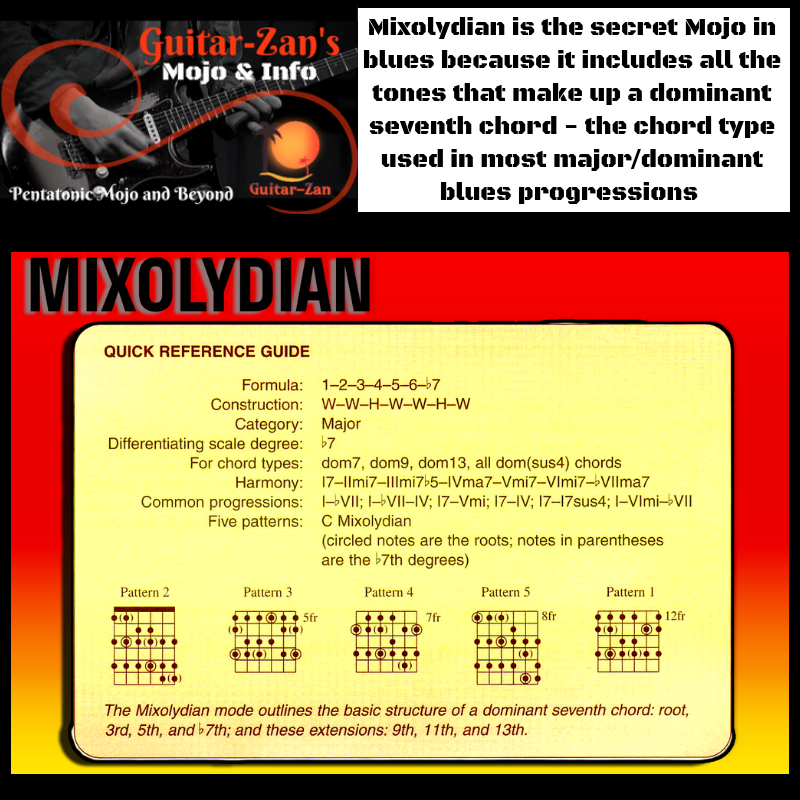Mixolydian Scale Mojo
Mixolydian Scale For Blues Guitar
When used together with the blues scale, the Mixolydian scale can add some killer mojo, it can even add a bit of Santana Flavor. Again, knowing your blues scale and major scales will help open up your mojo trick bag.
So with the 1, 3, 5 jive, we add the ♭7 note that makes up a dominant seventh chord, making Mixolydian a natural dominant scale.
This is where some "Chord Tone Soloing" will bring out the mojo of your soloing, these are going to be your target notes for your phrases and lines you improvise with. The other tones - the 2, 4 and 6 - can be thought of as "color tones" that we'll use for your phrases, and connect your lines.
What is chord tone soloing? The simplest definition I can give you is playing
the notes of a chord while you're on that chord. Pretty simple in theory, but it does require some practice and don't worry, it's well worth it.
Jeff McErlain
So the Mixolydian mode is the only major scale that has a flatted 7th degree. When you emphasize this tone in your phrases this will give you that Mixolydian mojo.
Mixolydian Scales To Use In a 1-4-5 Blues (Key of C)
-
Mixolydian Scale Shapes for the Blues
So the standard three-chord twelve bar blues progression (AKA the 1, 4, 5), will use a different Mixolydian pattern for each of the chords. Unlike scales such as minor pentatonic, a single Mixolydian scale will not do it for all the changes.
Because the 1 chord(C7) is the reference for the key you're playing in. So if you're in the key of C, position the 1(root note) of the 1 chord on C (8th fret). See Pattern 5

The root note is circled-Mixolydian Patterns Once you have the 1 chord position, the 4 & 5 chords can be made to fall into the same position. Use Pattern 2 for the 4 & 5 chords where the root is located on the 5th string.

Tips to Learn The Guitar Fretboard When have these shapes down, you can extend them to reach higher places on the neck.
Dominant 7th Tones

Check out Major Scale - Major Mojo As I said, it's good to know where these strong, dominant 7th chord tones are located within the Mixolydian scale. This is so you can target those tones in your phrases. Learning your Triad shapes as well as the notes names will open up many doors for your soloing and improvising. You can use them as arpeggios to connect your lines.
Spend time learning where these chord tones are in the 1, 4 and 5 patterns...
-
Phrasing Tips
Use the following tips to build up your improvisation mojo trick bag...
- Start by playing just the chord tones over each chord, either one per chord or arpeggiating each chord. This will get you used to targeting these tones as the chord changes, keeping your lines connected with the underlying chord changes.
- Build simple three/four-note phrases over each chord that land on one of the chord tones.
- Try using three/four-note arpeggios as "lead-ins" to your phrases, or to break up your phrases, essentially outlining the chord within the phrase.
- Practice linking phrases together through the chord changes. Again, the chord tone positions will help you move into place for the current chord.
- Gradually add in techniques such as bends, slides, hammer-ons, and pull-offs to add more mojo to your phrases.
-
Conclusion
If you liked this lesson, the biggest thanks, I can get is for you to like my facebook page and leave a post with what you liked about it. As always, feel free to contact me with your questions, concerns, etc. I am here to help!




































